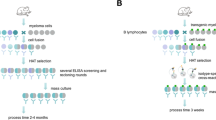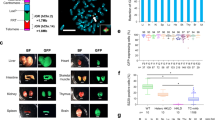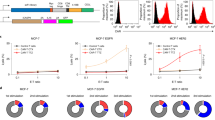Abstract
XENOIMMUNISATION with human cells or isolated molecules found on the surface of human cells results in the production of antibodies to a variety of human alloantigens (refs 1–3 and unpublished results). The genetic loci which specify the antigens being recognised can then be determined by using rodent–human hybrids containing various human chromosomes as target cells. In this manner, chromosome 11 has been found to include genes coding for a series of antigens designated AL (refs 1, 4) or HSA-1 (ref. 2) and chromosome 15 to code for β2 microglobulin3. Murine–human somatic cell hybrids with one or a limited number of human chromosomes have been used by us and by others to obtain antisera in mice syngeneic to the mouse parental cells reactive with antigens coded for by specific human chromosomes2,5–7. The advantage of this method is that antisera generated are specific for the antigen(s) coded for by a particular human chromosome and the reactivity is to a limited number of human cell surface antigens. This allows for both systematic genetic mapping of these antigens and detection of previously unknown cell surface molecules. Chromosome 6 has been shown both by pedigree analysis8 and by the use of interspecific somatic cell hybrid target cells9 to be the location of the genes coding for the serologically defined antigens (HLA) of the major histocompatibility complex (MHC). We have used a human–mouse somatic cell hybrid containing several human chromosomes, including chromosome 6, to immunise mice syngeneic to the mouse parental cell. The reactivity of the absorbed antiserum has been analysed both serologically and by sodium dodecyl sulphate polyacrylamide gel electrophoresis after immunoprecipitation. Evidence is presented here to show that mice immunised with somatic cell hybrids containing human chromosome 6 produce antibody which reacts with HLA as well as with other human lymphocyte cell surface antigens.
This is a preview of subscription content, access via your institution
Access options
Subscribe to this journal
Receive 51 print issues and online access
$199.00 per year
only $3.90 per issue
Buy this article
- Purchase on Springer Link
- Instant access to full article PDF
Prices may be subject to local taxes which are calculated during checkout
Similar content being viewed by others
References
Puck, T. T., Wuthier, P., Jones, C. & Kao, F.-T. Proc. natn. Acad. Sci. U.S.A. 68, 3102–3106 (1971).
Buck, D. W. & Bodmer, W. F. Cytogenet. Cell Genet. 14, 257–259 (1975).
Goodfellow, P. N. et al. Nature 254, 267–269 (1975).
Moore, E. E., Jones, C. & Puck, T. T. Cytogenet. Cell Genet. 17, 89–97 (1976).
Buck, D. W., Goss, S. J. & Bodmer, W. F. Cytogenet. Cell Genet. 16, 99–100 (1976).
Revel, M., Bach, D. & Ruddle, F. H. Nature 260, 139–141 (1976).
Aden, D. P. & Knowles, B. B. Immunogenetics 3, 209–221 (1976).
Lamm, L. U. et al. Hum. Heredity 24, 273–284 (1974).
Van Someren, H. et al. Proc. natn. Acad. Sci. U.S.A. 71, 962–965 (1974).
Croce, C. M., Aden, D. & Koprowski, H. Proc. natn. Acad. Sci. U.S.A. 72, 1397–1400 (1975).
Croce, C. M., Girardi, A. J. & Koprowski, H. Proc. natn. Acad. Sci. U.S.A. 70, 3617–3620 (1973).
Hynes, R. O. Proc. natn. Acad. Sci. U.S.A. 70, 3170–3174 (1973).
Laemmli, U. K. Nature 227, 680–685 (1970).
Springer, T. A., Mann, D. L., DeFranco, A. L. & Strominger, J. L. J. biol. Chem. 252, 4682–4693 (1977).
Bernoco, D., Cullen, S., Scudeller, G., Trinchieri, G. & Ceppelini, R. in Histocompatibility Testing (eds Dausset, J. & Colombani, J.) 527–537 (Munksgaard, Copenhagen, 1972).
Hauptfeld, V., Hauptfeld, M. & Klein, J. J. exp. Med. 141, 1047–1057 (1975).
Carnaud, C., Fadoi-Ghotbi, M., Lesavre, P. & Bach, J. I. Eur. J. Immun. 7, 81–85 (1977).
Burakoff, S. J., Dorf, M. E. & Benacerraf, B. J. Immun. 118, 1795–1798 (1977).
Author information
Authors and Affiliations
Rights and permissions
About this article
Cite this article
ADEN, D., MAUSNER, R. & KNOWLES, B. Production of HLA antibody in mice immunised with syngeneic mouse–human hybrid cells containing human chromosome 6. Nature 271, 375–377 (1978). https://doi.org/10.1038/271375a0
Received:
Accepted:
Published:
Issue Date:
DOI: https://doi.org/10.1038/271375a0
This article is cited by
-
Immunochemical analysis of anti-HLA-A2, HLA-A3, and HLA-B27 xenoantisera elicited with hybrids between human and murine cells
Immunogenetics (1981)
-
Everything the pediatrician ever wanted to know about HLA but was afraid to ask
European Journal of Pediatrics (1980)
Comments
By submitting a comment you agree to abide by our Terms and Community Guidelines. If you find something abusive or that does not comply with our terms or guidelines please flag it as inappropriate.



